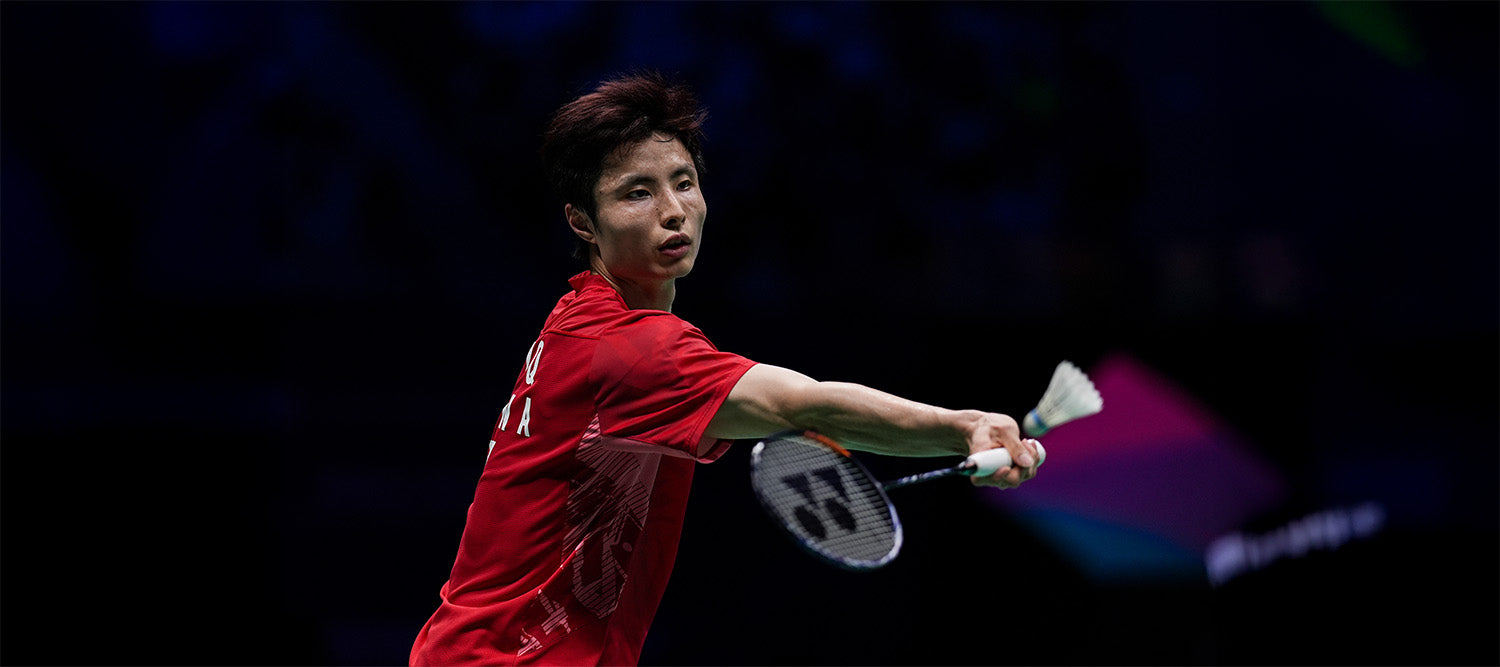
-
-
-
-
-
-
Yonex Arcsaber 7 Tour Badminton Racket
Sale price 144,90 € Regular price169,90 € -
-
OLIVER Energetic K7 Badminton Racket
Regular price 129,90 € -
OLIVER Microtec 10 Badminton Racket
Sale price 114,90 € Regular price149,90 € -
-
Filter
Rackets for every level of play
Find the right badminton racket – whether you're just starting out, a regular club player, or a tournament contender. We have the right models for all ages and skill levels.
-
Badminton rackets for professionals & tournamen...
-
Badminton rackets for advanced players
-
Badminton rackets for beginners
-
Badminton rackets for children
Badminton Racket Finder
Not sure which racket is right for you? With our racket finder, you can find the right model in no time.
Badminton Racket Guide
A suitable badminton racket is the key to a better feel, more control, and more fun on the court. At Bash Badmintonshop, you'll find a wide selection of carefully selected badminton rackets from Yonex, Oliver, and Victor —for beginners, advanced players, and competitive players.
To help you find the perfect racket for your playing style, we'll show you what's important: grip size, weight, balance, flexibility, string tension, and material – all the key factors explained in simple terms.

Handle size
Grip size influences your feel, control, and hand pressure. Yonex and Oliver specify it in G-ratings— the larger the number, the narrower the grip (e.g., G5 = narrow, G3 = thicker).
At Bash Badmintonshop, we've selected our range so that all rackets have rather narrow handles . This allows you to customize the thickness with an overgrip – flexible, affordable, and possible at any time.
This adjustment makes your badminton rackets versatile – whether you prefer fast drives, precise net play or powerful smashes.
How do I find the right grip size for my badminton racket?
If you want to determine the right grip size when buying a badminton racket, the following trick will help: Grip the racket normally, just as you would hold it during play. There should be about a finger's width of space between your thumb and the rest of your fingers. Do your fingers overlap? → The grip is too small. Is the gap too large? → The grip is too thick, and control suffers. Our tip: Choose a slightly smaller grip size and adjust it with one or more overgrips. This way, you remain flexible and can optimize the grip at any time – without compromising comfort or game control.
Why is grip size so important for your game?
The right grip size for your badminton racket ensures more control over the racket head, better power transmission, improved ball feel, and a lower risk of injury or strain. A well-adjusted grip has an immediate positive impact, especially during fast rallies, intense drives, or precise net play.
Flexibly adjust grip size instead of setting it
Whether you're buying a Yonex badminton racket or an Oliver model, you don't have to worry about choosing the "wrong" grip thanks to the individually adjustable grip sizes via overgrips. At Bash Badmintonshop, we ensure that our badminton rackets are equipped from the outset so that every player can adjust the grip – whether for tournament conditions, recreational play, or intensive training sessions. If you're unsure which grip size is right for you or how to adjust it, we're happy to help you – just contact us!

Weight: Light, medium or heavy?
The weight of a badminton racket influences how fast and controlled your strokes are. It plays a crucial role in your game, especially during fast rallies, long matches, or powerful smashes.
Weight classes at a glance:
Lightweight badminton rackets (75-83 g)
These rackets enable particularly quick reactions and fatigue-free play, and are perfect for defensive styles, fast drives, and fast net play. They are often used by doubles pairs or technical singles players.
Medium-weight badminton rackets (84-87 g)
A true all-rounder. This weight class is ideal for players who value a balanced combination of power and control. Many models from Yonex, Oliver, and Victor fall into this category.
Heavy badminton rackets (88–90 g)
For maximum power. The heavier weight allows for powerful clears and smashes with less effort. It's especially popular with offensive players with good technique.
Conclusion on weight
When purchasing a badminton racket, you should consider your playing level, technique, and fitness level. Lighter rackets are suitable for beginners, intermediate players benefit from medium-weight rackets, and experienced competitive players often opt for heavier models for more power in attack.

Balance: Control, speed or power?
The balance of a badminton racket determines how the weight is distributed across the racquet. It directly influences how the racket feels in your hand and how you can manipulate it—especially during smashes, drives, and net duels.
Balance types in comparison:
Head-Heavy (top-heavy)
The weight is more concentrated in the head. These models are perfect for powerful, offensive shots like smashes. Many Yonex Astrox and Oliver Smash models utilize this balanced shape to deliver maximum power.
Head-Light (handle-heavy)
Enter the Here, the center of gravity is closer to the handle. This results in faster reactions, high maneuverability, and perfect control when playing at net. Especially popular with doubles players or defensive players.
Even-Balance (balanced)
The center of gravity is centrally located in the blade. This type offers a good blend of control, power, and versatility. Ideal for all-around players.
Attacking player?
Do you love aggressive attacking shots and smashes? Choose a head-heavy badminton racket.
Fast racket movements?
Do you prefer fast racket movements at the net? Then a head-heavy racket is the right choice.
Attacking and defensive players?
If you need both, then choose a well-balanced model from Yonex or Oliver.

Shaft flexibility: control, power or playing comfort?
The flexibility of a badminton racket describes how much the shaft bends during fast movements and strokes. This property significantly influences how much energy is stored during the swing and transferred to the shuttlecock at the moment of impact. Depending on your playing style, technique, and skill level, the right shaft flexibility is a crucial criterion when purchasing a badminton racket .
Flexible shaft
- Offers high elasticity and thus generates more power at lower swing speed
- Supports players with slower or medium swing speed
- Forgives technical errors and offers a comfortable feel
- Particularly suitable for beginners and recreational players
Medium stiff shaft
- Good mix of energy transfer and control
- Provides more precise feedback than flexible shafts
- Ideal for advanced players who want to develop and refine their technique
Stiff shaft
- Low bending = direct, precise impact transmission
- Ideal for fast swing movements with a lot of power
- More control in aggressive moves, especially in singles
- Is especially preferred in competitions and by tournament players
When is which shaft suitable?
For more power
Do you have a slower swing or want more power with less effort? → Choose a flexible shaft.
For more control
Are you an advanced skier looking for more control and feedback? → A medium-stiff shaft is a good choice.
For more precision
Do you play fast, precisely, and at a high level? → A stiff shaft provides the necessary stability and accuracy.
Tip
Many of Yonex 's best badminton rackets (e.g., from the Astrox or Arcsaber series), as well as high-performance models from Oliver , are available in various flex levels. So you're guaranteed to find the model that perfectly suits your playing style.

String tension: balancing power, control & precision
The string tension of your badminton racket significantly influences how the racket behaves at impact. It determines how much power you can generate, how precise your shots are, and how forgiving your racket is. A well-adjusted stringing system is therefore crucial for your playing feel.
Low string tension (8–9 kg)
- Larger sweet spot = higher error tolerance
- More power with less effort
- Ideal for beginners or players with a soft hitting technique
- The strings act like a trampoline and support longer ball contacts
Medium string tension (9.5–10.5 kg)
- Good compromise between power and control
- Popular with advanced recreational players and ambitious club players
- Allows clean, powerful shots with good precision
High string tension (11–12 kg)
- Maximum control during fast play
- Smaller sweet spot, requires precise timing
- For tournament players with sophisticated technique and strong hitting power
- Perfect for aggressive attacking play with fast drives
Further influences on string tension
- Temperature: Strings become stiffer in cold weather and more elastic in warm weather
- String material: Thicker strings last longer, thinner ones offer more ball feel
- Playing frequency: If you play a lot, you should have your tennis restrung regularly
Our tip
We can string your Yonex or Oliver badminton racket to your preferred tension – whether you're looking for more control, power, or a balanced feel. Just contact us, and we'll be happy to advise you on string tension, string selection, and the right combination for your level.

Materials: Lightweight, stable and powerful
The material of a badminton racket is a key factor in its performance, durability, and overall feel. The choice of material influences not only the weight, but also the stiffness, vibration dampening, and power of the racket. Modern badminton rackets are usually made of innovative composite materials.
Carbon / Graphite (carbon fiber)
- Ultra-light, extremely stable and low-vibration
- Best energy transfer with low weight
- Particularly popular with competitive players and ambitious hobby players
- Installed in almost all Yonex and Oliver high-end rackets
- Ideal for fast play, precise placements and high stroke frequencies
Nanomaterials / High-modulus graphite
- Improved shock absorption and rigidity
- Even more efficient energy transfer to the ball
- Increased durability despite extremely lightweight construction
- Used in premium models such as the Yonex Astrox or Arcsaber series
Aluminum
- Robust entry-level material, well suited for beginners
- Low price, easy handling
- Less flexible, limited stringing options
- Often used in rackets for schools, recreational sports or children
Steel
- Very resistant and durable
- Significantly heavier than carbon or aluminum
- Rare in modern competition models, but common in inexpensive entry-level rackets
- More suitable for occasional gaming
Material conclusion
If you're looking to buy a high-performance badminton racket , you should opt for high-quality materials like carbon or graphite . These materials offer the perfect combination of lightness, stability, and control. At Bash Badmintonshop, you'll find a wide selection of carbon badminton rackets from Yonex and Oliver , optimized for all levels of play—from recreational players to professionals.
Tip: When buying, pay attention to the interplay of material, weight, balance and flexibility – because only the right combination makes your badminton racket truly strong.

Which badminton racket suits your level?
Whether you're a beginner, an advanced club player, or an experienced competitive player, your playing level should be the basis for choosing your badminton racket. Only a racket that matches your skill level can truly improve your game.
For beginners
- Lightweight badminton rackets with a head-heavy or balanced balance
- Flexible shaft for more power without much effort
- Low string tension for a larger sweet spot and better forgiveness
- Materials such as aluminum or lightweight carbon for easy handling
For advanced players
- Medium stiff shaft for more control on powerful shots
- Even-balance or slightly head-heavy rackets for versatile play
- Medium to higher string tension for better feedback
- High-quality carbon for stability, precision and vibration damping
For tournament and competitive players
- Stiff shaft for maximum control at high swing speeds
- Head-heavy balance for strong smashes and powerful clears
- High string tension for precise strokes at high playing speed
- Use of premium technologies such as Namd in Yonex Astrox or high-modular graphite in Oliver Pro models
Tip
Are you unsure about your playing level? We're happy to advise you and help you find the perfect racket – tailored to your individual abilities and goals.

Playing style: Offensive power or defensive control?
Your personal playing style has a major influence on which badminton racket suits you best. Whether you prefer attacking, defending, or a balanced game, you'll find the right recommendation here.
For offensive players
- Head Heavy racket for more power in smashes
- Stiff or medium-stiff shaft for direct energy transfer
- Higher string tension for precise, powerful strokes
- Suitable for single players with strong technique and good timing
For defensive players
- Head-Light or Even-Balance for maneuverability and quick reactions
- Light weight to relieve arm and wrist strain
- Flexible shaft for longer ball contacts and controlled return play
- Particularly suitable for doubles or reactive play
For all-rounders
- Even-balanced clubs with medium-stiff shaft
- Good mix of control, power and versatility
- Recommended for players who do not want to commit to a single style of play
Tip
Many models from Yonex (e.g. Arcsaber 7 or 11 Pro) and Oliver offer you the flexibility to adapt optimally to every playing situation.
How to find the perfect badminton racket for you
The 3-step guide





